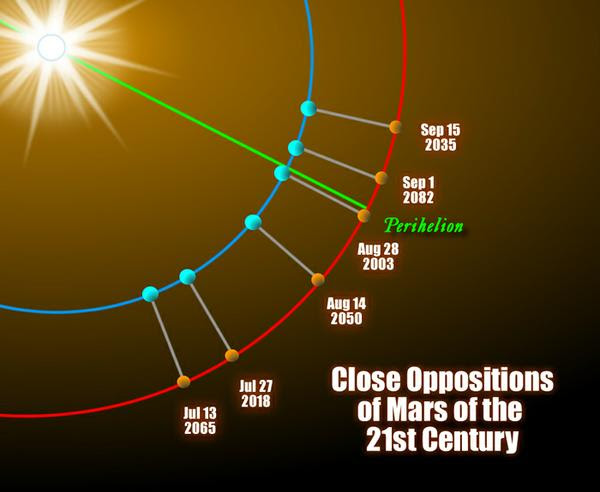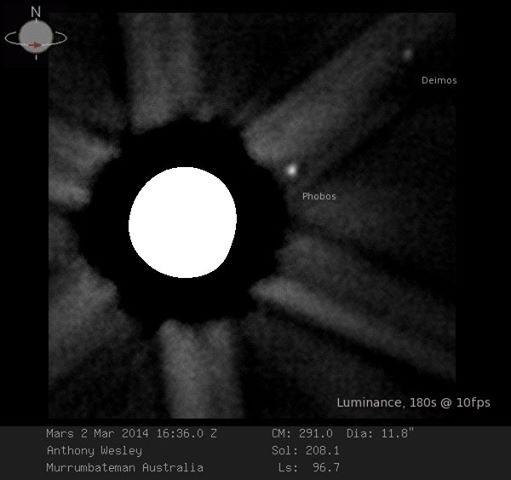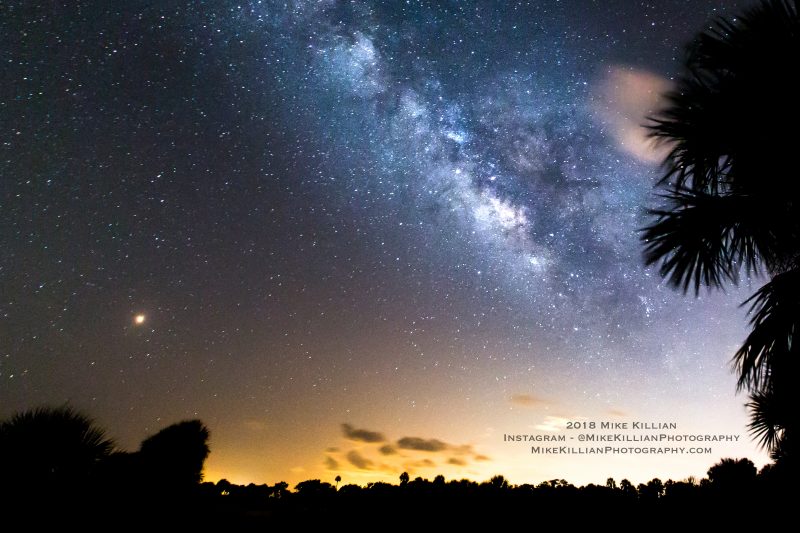
On any of these next few nights – July 25 to 27, 2018 – watch for the moon and the very bright red object near it. That red “star” is really a planet, Mars. On July 27, Mars comes to opposition in our sky for the first time since May 22, 2016. That’s when our planet Earth, in its smaller orbit around the sun, passes more or less in between the sun and Mars. The 2018 martian opposition happens on July 27 around 5 UTC (1 a.m. EDT … 10 p.m. PDT on July 26; translate UTC to your time).
Opposition is a special time for any superior planet. Around the time of opposition, a superior planet comes closest to Earth for the year and, in turn, shines at its brightest best in Earth’s sky. Moreover, any planet at opposition – being opposite the sun – rises in the east at sunset, climbs to its highest point in the sky at midnight, and sets in the west around sunrise.
And so Mars, now opposite the sun, shines brightly all night long.
On July 27, when Mars is at opposition, the full moon will be near Mars in the sky. And – as seen from Earth’s Eastern Hemisphere – there will be a total eclipse of the full moon. Click here to learn more about the July 27 total lunar eclipse.
Oppositions of Mars happen about every two years. That makes sense because Earth takes a year to orbit the sun, and Mars takes about two years. About every two years, we gain a lap on Mars, passing between it and the sun.
Not all Mars’ oppositions are equal, and 2018 brings Mars’ brightest appearance in our sky since 2003. Since early July, Mars has shone more brightly than the king planet Jupiter, which is generally the fourth-brightest sky object after the sun, moon and planet Venus. In 2018, Mars shines more brightly than Jupiter from about July 7 to September 7, 2018. You can’t miss Mars right now! On July 25 to 27, even the drenching moonlight won’t wash the red planet from the nighttime sky.
Extra-close oppositions of Mars (less than 37 million miles or 60 km) recur in periods of 15 to 17 years. The last extra-close Martian opposition happened on August 28, 2003, and the next one will occur on September 15, 2035.
Extra-close oppositions happen when we go between Mars and the sun around the time Mars is near perihelion – its closest point to the sun. That makes sense, too, right?

The inner dark circle represents Earth’s orbit around the sun; the outer dark circle represents Mars’ orbit. When Mars is near the sun around the time of opposition, as it was in 2003 and is again in 2018, we have an extra-close opposition. On the other hand, 2012 was a particularly distant opposition of Mars because Mars was far from the sun in its orbit around opposition-time. Diagram via Sydney Observatory.
An extra-far opposition (over 62 million miles or 100 km) last took place on March 3, 2012, when Mars was near aphelion – its farthest point from the sun. As a basis of comparison, the 2018 opposition of Mars finds the planet about 28 million miles (45 million km) closer than the extra-far opposition of 2012.
Extra-far oppositions also recur in periods of 15 to 17 years, and the next one will happen on February 19, 2027.

Extra-close oppositions of Mars happen every 15 to 17 years, when Earth passes between the sun and Mars around the time Mars is closest to the sun in its orbit. Illustration via ClassicalAstronomy.com. Used with permission.
By the way, Mars will come closest to Earth some four days after opposition, on July 31, 2018.
If Earth and Mars orbited the sun in perfect circles and on the same exact plane, Earth would come closest to Mars right at opposition. However, the orbits of both Earth and Mars are not perfect circles; they are ellipses, like circles someone sat down on.
Mars always comes closest to Earth near (but not necessarily on) opposition. The time interval between opposition and Mars’ nearest point to Earth is no greater than 8.5 days, and can be as little as 10 minutes.
Read more about the 2018 opposition of Mars: Brightest since 2003

At the opposition of Mars in 2014 Anthony Wesley caught both of Mars’ moons. Here you see brighter and closer Phobos and fainter, more distant Deimos.
Bottom line: July 2018 is the best time in nearly 15 years to see Mars. Earth passes between Mars and the sun on July 27, 2018 (the martian opposition). Earth and Mars will be closest on July 31, 2018.
from EarthSky https://ift.tt/2v4UVvZ

On any of these next few nights – July 25 to 27, 2018 – watch for the moon and the very bright red object near it. That red “star” is really a planet, Mars. On July 27, Mars comes to opposition in our sky for the first time since May 22, 2016. That’s when our planet Earth, in its smaller orbit around the sun, passes more or less in between the sun and Mars. The 2018 martian opposition happens on July 27 around 5 UTC (1 a.m. EDT … 10 p.m. PDT on July 26; translate UTC to your time).
Opposition is a special time for any superior planet. Around the time of opposition, a superior planet comes closest to Earth for the year and, in turn, shines at its brightest best in Earth’s sky. Moreover, any planet at opposition – being opposite the sun – rises in the east at sunset, climbs to its highest point in the sky at midnight, and sets in the west around sunrise.
And so Mars, now opposite the sun, shines brightly all night long.
On July 27, when Mars is at opposition, the full moon will be near Mars in the sky. And – as seen from Earth’s Eastern Hemisphere – there will be a total eclipse of the full moon. Click here to learn more about the July 27 total lunar eclipse.
Oppositions of Mars happen about every two years. That makes sense because Earth takes a year to orbit the sun, and Mars takes about two years. About every two years, we gain a lap on Mars, passing between it and the sun.
Not all Mars’ oppositions are equal, and 2018 brings Mars’ brightest appearance in our sky since 2003. Since early July, Mars has shone more brightly than the king planet Jupiter, which is generally the fourth-brightest sky object after the sun, moon and planet Venus. In 2018, Mars shines more brightly than Jupiter from about July 7 to September 7, 2018. You can’t miss Mars right now! On July 25 to 27, even the drenching moonlight won’t wash the red planet from the nighttime sky.
Extra-close oppositions of Mars (less than 37 million miles or 60 km) recur in periods of 15 to 17 years. The last extra-close Martian opposition happened on August 28, 2003, and the next one will occur on September 15, 2035.
Extra-close oppositions happen when we go between Mars and the sun around the time Mars is near perihelion – its closest point to the sun. That makes sense, too, right?

The inner dark circle represents Earth’s orbit around the sun; the outer dark circle represents Mars’ orbit. When Mars is near the sun around the time of opposition, as it was in 2003 and is again in 2018, we have an extra-close opposition. On the other hand, 2012 was a particularly distant opposition of Mars because Mars was far from the sun in its orbit around opposition-time. Diagram via Sydney Observatory.
An extra-far opposition (over 62 million miles or 100 km) last took place on March 3, 2012, when Mars was near aphelion – its farthest point from the sun. As a basis of comparison, the 2018 opposition of Mars finds the planet about 28 million miles (45 million km) closer than the extra-far opposition of 2012.
Extra-far oppositions also recur in periods of 15 to 17 years, and the next one will happen on February 19, 2027.

Extra-close oppositions of Mars happen every 15 to 17 years, when Earth passes between the sun and Mars around the time Mars is closest to the sun in its orbit. Illustration via ClassicalAstronomy.com. Used with permission.
By the way, Mars will come closest to Earth some four days after opposition, on July 31, 2018.
If Earth and Mars orbited the sun in perfect circles and on the same exact plane, Earth would come closest to Mars right at opposition. However, the orbits of both Earth and Mars are not perfect circles; they are ellipses, like circles someone sat down on.
Mars always comes closest to Earth near (but not necessarily on) opposition. The time interval between opposition and Mars’ nearest point to Earth is no greater than 8.5 days, and can be as little as 10 minutes.
Read more about the 2018 opposition of Mars: Brightest since 2003

At the opposition of Mars in 2014 Anthony Wesley caught both of Mars’ moons. Here you see brighter and closer Phobos and fainter, more distant Deimos.
Bottom line: July 2018 is the best time in nearly 15 years to see Mars. Earth passes between Mars and the sun on July 27, 2018 (the martian opposition). Earth and Mars will be closest on July 31, 2018.
from EarthSky https://ift.tt/2v4UVvZ


Aucun commentaire:
Enregistrer un commentaire